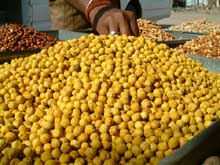Chickpeas Nutrition Facts

Chickpeas are part of the Fabaceae family, which is the botanical name of a large group of plants commonly known as legumes. Chickpeas are grown mainly in India, Asia, Pakistan and the Mediterranean. They are edible pulses that may be used in salads and stews. They can also be modified and used in many various forms.
Ground chickpeas are used to create chickpea flour, which is also called gram flour. Ground, molded chickpeas are used in falafels — a very popular vegetarian dish — while cooked and ground chickpeas form a paste, commonly known as hummus.
Chickpeas are a good source of folate and protein. Folate is a water-soluble B vitamin that occurs naturally in food, which, according to the New York-Presbyterian Hospital/Weill Cornell Medical Center, may help to reduce your risk of colorectal cancer.
Chickpeas are also very high in dietary fiber and thus are a healthy food source, especially as a source of carbohydrates for persons with insulin sensitivity or diabetes. They are low in fat, and most of the fat content is polyunsaturated.
Chickpeas are also a significant source of calcium (190 mg/100 g). Some sources quote it as equal to yogurt and close to milk.
Chickpeas also contain high mineral content. According to the International Crops Research Institute for the Semi-Arid Tropics, on an average, chickpea seed contains:
- phosphorus (340 mg/100 g)
- calcium (190 mg/100 g)
- magnesium (140 mg/100g)
- iron (7 mg/100 g)
- zinc (3 mg/100 g)
According to the United Nations Food and Agriculture Organization (FAO), in 2005 the top ten producers of chickpeas were India, Pakistan, Turkey, Myanmar, Iran, Ethiopia, Mexico, Australia, Canada and Syria. India produced 5,470,000 tons of chickpeas, while Pakistan in second place produced 868,000 tons of chickpeas.
Author: Dimi Ingle.
Copyright: Remedium. This article may not be copied, in whole or in part, without the written consent of Remedium.
|